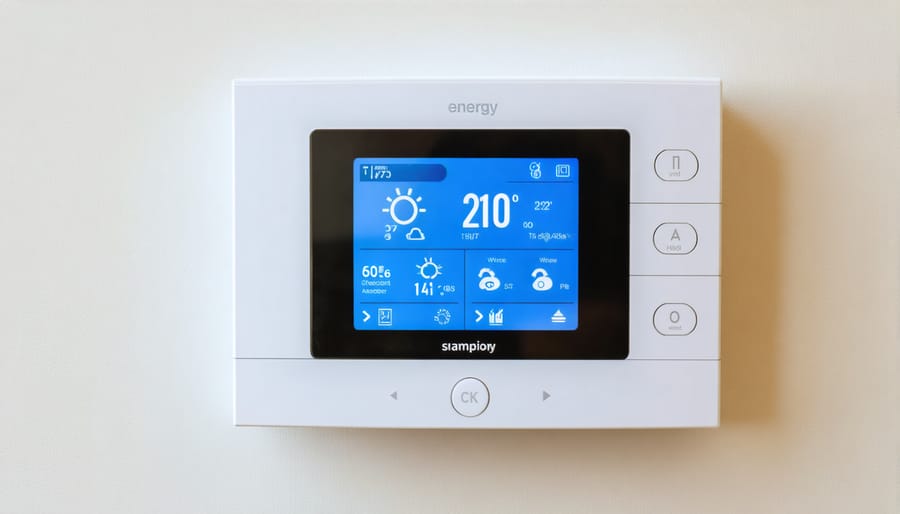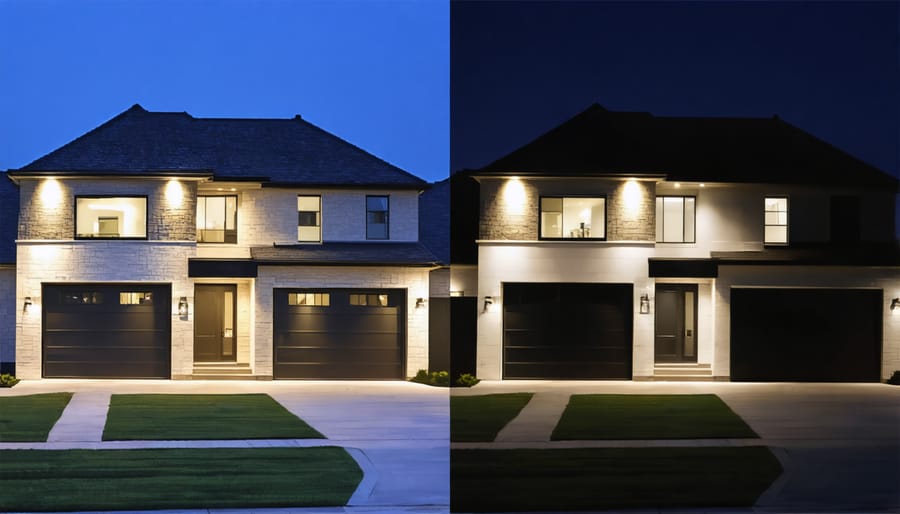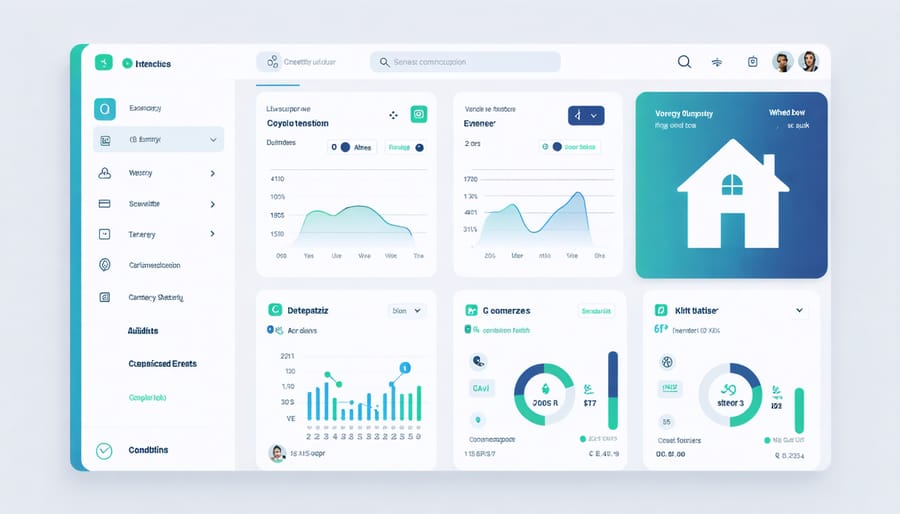Transform your home into an energy-efficient sanctuary with smart devices that slash utility bills while enhancing daily comfort. Modern energy-saving home automation systems have revolutionized how we manage power consumption, offering average savings of 15-30% on monthly energy costs.
Smart thermostats learn your schedule and automatically adjust temperatures, cutting heating and cooling expenses by up to $180 annually. Motion-sensing lights eliminate wasted electricity in empty rooms, while smart plugs monitor and control energy-hungry appliances even when you’re away. These intelligent devices work seamlessly together, providing real-time energy usage data through smartphone apps that help you make informed decisions about your home’s efficiency.
Beyond the immediate cost benefits, these innovations offer unprecedented convenience – imagine adjusting your home’s temperature during your commute or receiving instant alerts about unusual energy spikes. With minimal upfront investment and straightforward DIY installation options, smart home technology represents a practical step toward sustainable living and reduced utility bills.
Smart Thermostats: The Foundation of Energy-Efficient Security
Motion-Based Temperature Control
Motion sensors have revolutionized the way we manage both home security and energy efficiency. These clever devices can detect when rooms are occupied and automatically adjust your heating and cooling systems accordingly, helping you save money while maintaining optimal comfort.
When integrated with your smart thermostat, motion sensors can create temperature zones throughout your home that respond to your family’s actual usage patterns. For instance, if no movement is detected in the living room for an hour, the system can automatically adjust the temperature to an energy-saving mode. When someone enters the room, it quickly returns to the preferred comfort setting.
The real magic happens in spaces like home offices or guest rooms that see intermittent use. Instead of heating or cooling these areas continuously, motion-based systems ensure climate control only when needed. Many homeowners report energy savings of 10-30% after installing these systems.
Setting up motion-based temperature control is surprisingly straightforward. Most modern smart thermostats come with compatible sensors that can be placed strategically around your home. For best results, position sensors at chest height in areas where they can detect regular movement without being blocked by furniture.
Pro tip: Consider using multiple sensors in larger rooms to ensure comprehensive coverage and more accurate occupancy detection. This prevents the system from mistakenly adjusting the temperature when someone is still in the room but out of range of a single sensor.

AI-Powered Energy Learning
Modern smart thermostats are revolutionizing how we manage our home’s energy consumption through AI-powered energy optimization. These intelligent devices do much more than simply turning your heating and cooling on and off – they actually learn from your daily routines and preferences to create a personalized comfort schedule.
Think of your smart thermostat as a thoughtful assistant that notices patterns in your lifestyle. It learns when you typically wake up, leave for work, return home, and go to bed. After a week or two of observation, it automatically adjusts temperatures to ensure your home is comfortable when you’re there and conserving energy when you’re not.
But the learning doesn’t stop there. These smart systems also factor in weather forecasts, humidity levels, and even how long it takes your home to heat up or cool down. They can detect when you’re away unexpectedly and adjust accordingly, preventing energy waste while maintaining security through occupancy monitoring.
The real magic happens in the background as the AI continuously fine-tunes its algorithms. It analyzes which temperature adjustments save the most energy while keeping you comfortable, and even learns from your manual overrides to better understand your preferences. Many users report seeing noticeable decreases in their energy bills within the first few months of installation, all while enjoying more consistent comfort levels throughout their homes.

Smart Lighting Systems That Do Double Duty
Automated Presence Simulation
One of the most innovative features of modern smart lighting automation is its ability to simulate occupancy when you’re away from home. This clever technology creates realistic lighting patterns that make your house appear lived-in while actually consuming less energy than leaving lights on continuously.
These systems work by learning your typical daily routines and replicating them when you’re away. Instead of lights staying on for hours, they’ll turn on and off in natural sequences – perhaps switching on in the kitchen during dinner time, moving to the living room in the evening, and finally to the bedroom at night. Some advanced systems even factor in seasonal changes in daylight hours to maintain authenticity.
You can easily customize these patterns through user-friendly apps, setting specific schedules for different rooms or creating random variations to make the simulation more convincing. Many systems also integrate with motion sensors and cameras, adding an extra layer of security by responding to activity around your home.
The energy savings are significant compared to traditional “leave the lights on” approaches. Modern LED smart bulbs typically use just 7-10 watts while operating, and their strategic activation means they’re only running when needed for the simulation. Plus, most systems include features like automatic dimming and shut-off timers to prevent unnecessary power consumption.
Motion-Activated Security Lighting
Motion-activated security lighting is a game-changer for both home security and energy efficiency. Unlike traditional security lights that stay on all night, these smart fixtures only illuminate when they detect movement, cutting your outdoor lighting energy consumption by up to 80%.
Installing motion sensors in key areas around your home creates an effective security perimeter without wasting electricity. The most strategic locations include entryways, driveways, side yards, and dark corners where intruders might try to hide. Modern motion-activated lights come with adjustable sensitivity settings, so you won’t have to worry about them triggering unnecessarily for small animals or swaying branches.
Many smart motion-activated lights now offer additional features that enhance their efficiency. Look for models with adjustable illumination levels, duration settings, and the ability to distinguish between people and animals. Some even connect to your smartphone, allowing you to customize settings and receive instant notifications when motion is detected.
Pro tip: Choose LED bulbs for your motion-activated fixtures to maximize energy savings. They use significantly less power than traditional bulbs and last much longer. For the best results, position your sensors at a height of 6-10 feet and angle them slightly downward to cover the most useful detection area.
Remember to clean your motion sensors every few months to ensure optimal performance, and test them regularly to maintain reliable security coverage.
Smart Window Solutions
Automated Climate Control
Smart windows are revolutionizing how we think about natural climate control in our homes. These innovative devices use electrochromic technology to automatically adjust their tint based on sunlight intensity and indoor temperature readings. During summer months, they darken to block excess heat and glare, reducing the need for air conditioning. In winter, they maximize natural light and heat gain, helping to warm your space naturally.
The system works through sensors that monitor both indoor and outdoor conditions. When the sun’s intensity increases, a small electrical charge triggers the window’s special coating to darken gradually. This process is seamless and can reduce your cooling costs by up to 25% during peak summer months. The windows also respond to your home’s temperature settings, working in harmony with your HVAC system for optimal efficiency.
Many smart windows can be controlled through your smartphone, allowing you to override automatic settings when needed. You can even schedule specific tinting patterns based on your daily routine, ensuring your home maintains comfortable temperatures while you’re away and is perfectly adjusted when you return.
Enhanced Security Features
Smart home security features work hand in hand with energy-saving capabilities, creating a powerful combination for modern homeowners. Motion sensors that trigger lights can deter intruders while ensuring energy isn’t wasted in unoccupied spaces. Smart doorbell cameras with LED lights consume minimal power while providing round-the-clock surveillance and peace of mind.
Many smart thermostats now include occupancy detection, which not only helps maintain optimal temperature but also serves as an additional security measure by monitoring unexpected movement. When integrated with smart lighting systems, these devices can create convincing presence simulations while you’re away, running on efficient schedules that minimize energy usage.
Voice-controlled security features add another layer of protection without increasing your energy footprint. You can check if doors are locked or lights are off using simple voice commands, preventing unnecessary trips around the house. Smart window sensors serve double duty by alerting you to break-in attempts while also notifying you of drafts that might affect your heating efficiency.
For maximum benefit, consider connecting these security features to your home automation hub, allowing them to work together seamlessly while maintaining energy-conscious operation.
Smart Home Hub Integration
Bringing all your smart home devices together under one unified system can dramatically improve both convenience and energy efficiency. A smart home hub serves as the brain of your home automation setup, allowing you to create powerful routines and maximize the benefits of integrated security and energy management systems.
To get started, choose a hub that’s compatible with your existing devices and future additions. Popular options like Samsung SmartThings, Apple HomeKit, and Amazon Alexa offer broad device support and user-friendly interfaces. Consider your current smart devices and check their compatibility before making a decision.
Once you’ve selected your hub, follow these steps for a successful integration:
1. Position your hub centrally in your home for optimal connectivity
2. Connect all compatible devices to your home’s Wi-Fi network
3. Add devices to your hub’s app one at a time
4. Create rooms or zones within the app for easier management
5. Set up basic automations before moving to more complex routines
The real magic happens when you create smart routines that combine security and energy savings. For example, you can program your hub to:
– Automatically adjust your thermostat and turn off lights when the security system is armed
– Trigger smart blinds to close during peak sunlight hours while running the AC
– Power down non-essential devices when no motion is detected for extended periods
– Activate outdoor lights and indoor scenes based on security camera activity
Remember to regularly update your hub’s software and connected devices to ensure optimal performance and security. Many hubs offer smartphone apps that let you monitor and control your home’s systems remotely, giving you peace of mind and the ability to make energy-saving adjustments on the go.
Pro tip: Start with simple automations and gradually build complexity as you become more comfortable with the system. This approach helps prevent overwhelming setups that might be difficult to troubleshoot later.
For the best results, look for devices that carry the “Works With” badge for your chosen hub platform. This ensures seamless integration and access to all features without complicated workarounds or third-party bridges.

As we’ve explored throughout this article, energy-efficient smart home security devices offer an impressive combination of protection and cost savings that modern homeowners can’t afford to ignore. These innovative technologies not only keep our homes safe but also help reduce our environmental footprint and monthly utility bills.
The future of smart home security looks even brighter, with emerging technologies promising even greater energy efficiency and seamless integration. We’re seeing rapid developments in AI-powered systems that can learn and adapt to your household’s patterns, further optimizing energy usage while maintaining robust security measures.
For homeowners just starting their smart home journey, beginning with a few key devices like smart thermostats and motion-sensor lighting can make a significant impact. As your comfort level grows, you can gradually expand your system to include more sophisticated features such as smart cameras and automated door locks.
The investment in energy-efficient security technology typically pays for itself within 12-24 months through reduced energy costs. Plus, many insurance companies offer discounts for homes equipped with smart security systems, adding another layer of financial benefit.
Remember, creating an energy-efficient, secure home isn’t just about installing devices – it’s about building a sustainable, comfortable living space that protects both your family and your wallet. As these technologies continue to evolve and become more accessible, they’ll play an increasingly vital role in the homes of tomorrow.
